GRE英语考试模拟试卷22试卷.doc
GRE(QUANTITATIVE)模拟试卷22(题后含答案及解析)
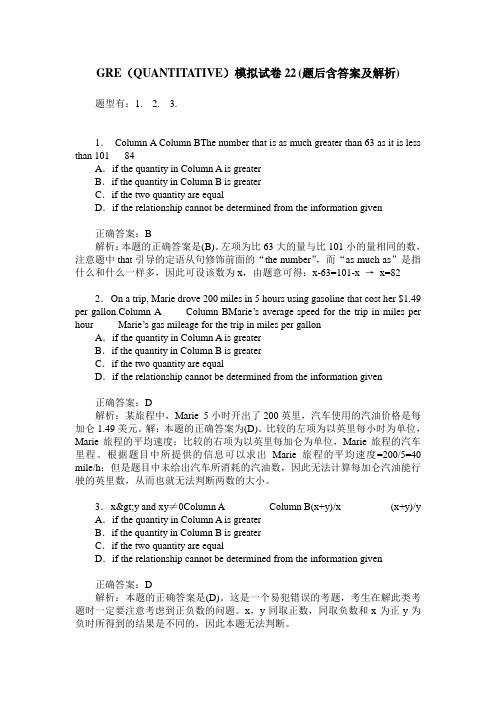
GRE(QUANTITATIVE)模拟试卷22(题后含答案及解析)题型有:1. 2. 3.1.Column A Column BThe number that is as much greater than 63 as it is less than 101 84A.if the quantity in Column A is greaterB.if the quantity in Column B is greaterC.if the two quantity are equalD.if the relationship cannot be determined from the information given正确答案:B解析:本题的正确答案是(B)。
左项为比63大的量与比101小的量相同的数,注意题中that引导的定语从句修饰前面的“the number”,而“as much as”是指什么和什么一样多,因此可设该数为x,由题意可得:x-63=101-x →x=822.On a trip, Marie drove 200 miles in 5 hours using gasoline that cost her $1.49 per gallon.Column A Column BMarie’s average speed for the trip in miles per hour Marie’s gas mileage for the trip in miles per gallonA.if the quantity in Column A is greaterB.if the quantity in Column B is greaterC.if the two quantity are equalD.if the relationship cannot be determined from the information given正确答案:D解析:某旅程中,Marie 5小时开出了200英里,汽车使用的汽油价格是每加仑1.49美元。
2022年GRE考试模拟卷

2022年GRE考试模拟卷(本卷共分为1大题50小题,作答时间为180分钟,总分100分,60分及格。
)单位:姓名:考号:一、单项选择题(共50题,每题2分。
每题的备选项中,只有一个最符合题意)1.The word "executing" in line 28 is closest in meaning toA.( judgingB.( sellingC.( explainingD.( producing2.According to paragraph 3, artists who work on public art projects are doing all of the following EXCEPTA.( creating artworks that are unusual in sizeB.( raising funds to sponsor various public projectsC.( exposing a large number of people to works of artD.( using new materials that are long—lasting3.I could barely follow the ______ story line; the numerous twists and turns in the plot made it extremely hard to comprehend.A.(A) convolutedB.(B) unambiguousC.(C) conventionalD.(D) resoluteE.(E) dependable4.CIRCUMSPECT:A.(A) intricateB.(B) recklessC.(C) dissonantD.(D) formativeE.(E) prudent5.MEDICINE : DOSE :: A.(A) surgeon : scalpel B.(B) paper : ream C.(C) treatment : hospital D.(D) ocean : water E.(E) office : decor6.DISCONCERTED:A.(A) composedB.(B) miserlyC.(C) relentlessD.(D) sheepishE.(E) perturbed7.CAPRICIOUS:A.(A) dogmaticB.(B) eccentricC.(C) steadfastD.(D) poignantE.(E) raucous8.PLETHORA:A.(A) rhetoricB.(B) presumptionC.(C) mutinyD.(D) deficiencyE.(E) figment9.COLLUSION : FRAUD :: A.(A) dissident : friend B.(B) eccentricity : normalcy C.(C) enigma : mistake D.(D) diatribe : insult E.(E) surplus : debit10.GLACIER : ICE ::A.(A) beach : sandB.(B) mountain : clouds C.(C) ship : harborD.(D) hammer : chisel E.(E) novel : characters11.RESERVOIR : LAKE :: A.(A) dam : riverB.(B) hub : wheelC.(C) canal : waterway D.(D) bank : streamE.(E) window : door12.Certain members of my family continued to lead ______ lives, often indulging in wild and ______ behavior.A.(A) chaotic .. impulsiveB.(B) temperate.. frenziedC.(C) moderate.. destructiveD.(D) arbitrary.. leisurelyE.(E) boisterous .. unpretentious13.In addition to advising the school newspaper staff, Mr. Mathison also regularly ______ the junior class regarding community service opportunities.A.(A) rallied againstB.(B) counseledC.(C) argued withD.(D) suppressedE.(E) emulated14.MALEVOLENT:A.(A) marredB.(B) meticulousC.(C) magnanimousD.(D) malcontentE.(E) malignant15.Her disheveled clothing and ______ hair surprised me; Amanda's appearance is normally very polished and chic.A.(A) orderlyB.(B) capaciousC.(C) unkemptD.(D) formalE.(E) striking16.GLIB:A.(A) pugnaciousB.(B) gleefulC.(C) guilelessD.(D) punctiliousE.(E) flippant17.The editors of the magazine are often criticized for the ______ of their opinion column, which frequently ______ from one side of an issue to the other.A.(A) monotony.. continuesB.(B) ingenuity.. settlesC.(C) unpredictability.. scuttlesD.(D) inconsistency .. vacillatesE.(E) rigidity.. dithers18.INSULAR:A.(A) insolventB.(B) cosmopolitanC.(C) ominousD.(D) biasedE.(E) perceptible19.DEPLORABLE:A.(A) eligibleB.(B) miserableC.(C) irreproachableD.(D) reprehensibleE.(E) intractable20.TACIT : EXPLICIT ::A.(A) lucid : muddledB.(B) negligible : obedientC.(C) odious : intactD.(D) pedantic : curiousE.(E) wily : expert21.REVIVE : EXHAUSTED ::A.(A) reward : superiorB.(B) refer : adjacentC.(C) replace : lostD.(D) rejuvenate : drainedE.(E) resume : interrupted22.People want to do more on Sundays becauseA.A. more shops are open.B.B. it is a good day to graze.C.C. they are tired on Saturdays.23.According to the diaries, in 1961 women rarely had free time on Sunday A.A. mornings.B.B. afternoons.C.C. evenings.24.肾的功能异常,骨络瘀阻可形成A.气瘤B.血瘤C.筋瘤D.肉瘤E.骨瘤25.FOSTER: DEVELOPMENT : : A.immunize: resistance B.nurture: fertilization C.adorn: sleekness D.chill: tepidity E.cultivate: profligacy26.DILETTANTE: COMMITMENT : : A.nonentity: consequence B.gourmand: self-restraint C.minimalist: elegance D.authoritarian: disregard E.malingerer: cunning27.CARESS:AFFECTION: : A.flush: decency B.salute: respect C.collapse: ennui D.obstruct: quandary E.apprehend: dread28.PHLEGMATIC: PERTURB : : A.ineffable: ignoreB.greedy: goad C.invincible: subdue D.peaceful: mollify E.bewildered: illuminate29.CABAL: ASSOCIATION : : A.archbishop: archdiocese B.mansion: palace C.factory: manufacturer D.plot: plan E.confrontation: spat30.DISSENTER: DOGMA : : A.profligate: doctrine B.patriot: conviction C.nonconformist: norm D.optimist: guide E.barrister: reason31.PERFIDY: LOYAL : : A.exorbitance: moderate B.perjury: ardent C.affection: faithful D.precision: accurate E.loathing: comely32.QUELL:A.deferB.directC.stimulateD.invokeE.corroborate33.POSTURE:A.demand randomlyB.act normallyC.detail meticulously D.advertise broadlyE.tread awkwardly34.INADVERTENCE:A.complete loyalty B.attentivenessC.group movement D.disagreeable characteristic E.powerful mind35.REPORTORIAL:A.reticentB.imaginativeC.taciturnD.normalE.improbable36.TENDENTIOUS:A.inclinedB.extremely industrious C.strongly hinderedD.irrelevant E.impartial37.IMMACULATE: A.sincere B.unnoticed C.accidental D.spotted E.distracted38.CARDINAL: A.indefinable B.diminutive C.understated D.inconsequential E.intangible39.FERROUS: A.magnetic B.rustyC.with no iron D.hydrated E.non-reactive40.ENDEMIC: A.apparent B.curable C.superficial D.alienE.intermittent41.HACKNEYED:A.carefulB.acceptableC.handyD.handyE.original42.While mimicking the thought of his mentor Socrates, who conceived of forms as existing on an ethereal, heavenly and ------- plane, Plato also argued that forms become ------- in objects.A.(A) abstract... rationalB.(B) condensed ... ratifiedC.(C) sacrilegious... profaneD.(D) transcendent... immanentE.(E) imaginative ... earthbound43.SCHOOL: FISH ::A.(A) television: programsB.(B) pride: lionsC.(C) committee: organizationD.(D) fowl: birdsE.(E) corral: livestock44.PERFIDY: LOYAL ::A.(A) exorbitance: moderateB.(B) perjury: ardentC.(C) affection: faithfulD.(D) precision: accurateE.(E) loathing: comely45.A faux pas--whether in social circles or in private--can be -------, as it focuses us on our shortcomings in ways that would otherwise go unnoticed, and helps create self-awareness.A.(A) embarrassmentB.(B) uselessC.(C) utileD.(D) rancorousE.(E) spontaneous46.Despite certain ------- habits of the North American screech owl, it performs the majority of its hunting alone, in alpine forests, unfettered by -------.A.(A) predatory... ecologyB.(B) instinctual ... behaviorC.(C) exogamous... kinshipD.(D) omnivorous... dietE.(E) diurnal... darkness47.RATIOCINATION: LOGIC ::A.(A) comprehension: pedagogyB.(B) interpretation: languageC.(C) orthography : philatelyD.(D) badminton: athleticsE.(E) oration: elocution48.Because many of the blacklists in the communications and entertainmentindustries were secret, the number of playwrights, script writers, novelists, and journalists who were ------- to stop writing permanently is -------.A.(A) happy... astoundingB.(B) forced ... unknownC.(C) unafraid ... impressiveD.(D) inclined... unsurprisingE.(E) remiss... inconceivable49.SCRUTINIZE: ADMIRE ::A.(A) imprison: hostB.(B) forewarn: rageC.(C) vacillate: resolveD.(D) duplicate: imitateE.(E) impel: push50.Though ------- in his youth, Muir grew in the fullness of time to acquire truly -------habits envied by even the most hardened of his fellow survivalists.A.(A) a stoic ... gourmetB.(B) a sycophant ... humbleC.(C) an eccentric ... practicalD.(D) a sensualist ... spartanE.(E) an ideologue ... catholic。
英语证书考试美国研究生入学考试(GRE)2022年模拟题2
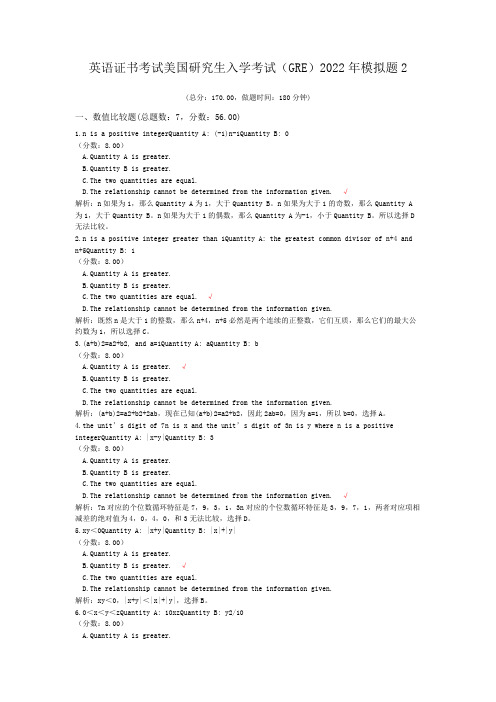
英语证书考试美国研究生入学考试(GRE)2022年模拟题2(总分:170.00,做题时间:180分钟)一、数值比较题(总题数:7,分数:56.00)1.n is a positive integerQuantity A: (-1)n-1Quantity B: 0(分数:8.00)A.Quantity A is greater.B.Quantity B is greater.C.The two quantities are equal.D.The relationship cannot be determined from the information given. √解析:n如果为1,那么Quantity A为1,大于Quantity B。
n如果为大于1的奇数,那么Quantity A 为1,大于Quantity B。
n如果为大于1的偶数,那么Quantity A为-1,小于Quantity B。
所以选择D 无法比较。
2.n is a positive integer greater than 1Quantity A: the greatest common divisor of n+4 and n+5Quantity B: 1(分数:8.00)A.Quantity A is greater.B.Quantity B is greater.C.The two quantities are equal. √D.The relationship cannot be determined from the information given.解析:既然n是大于1的整数,那么n+4,n+5必然是两个连续的正整数,它们互质,那么它们的最大公约数为1,所以选择C。
3.(a+b)2=a2+b2, and a=1Quantity A: aQuantity B: b(分数:8.00)A.Quantity A is greater. √B.Quantity B is greater.C.The two quantities are equal.D.The relationship cannot be determined from the information given.解析:(a+b)2=a2+b2+2ab,现在已知(a+b)2=a2+b2,因此2ab=0,因为a=1,所以b=0,选择A。
GRE北美试题22
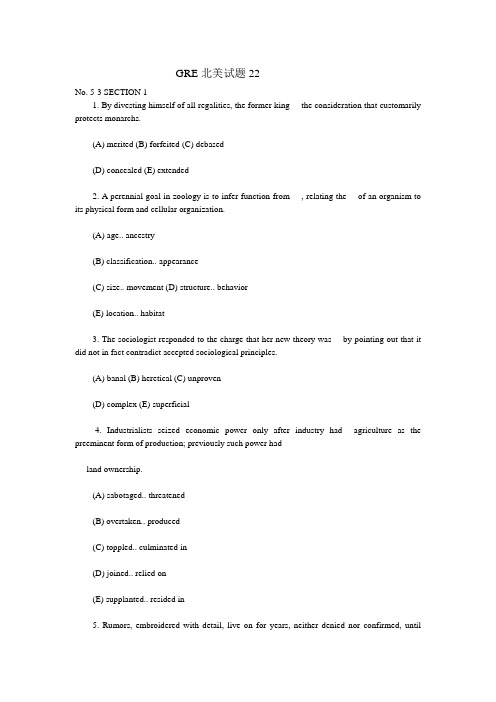
GRE北美试题22No. 5-3 SECTION 11. By divesting himself of all regalities, the former king----the consideration that customarily protects monarchs.(A) merited (B) forfeited (C) debased(D) concealed (E) extended2. A perennial goal in zoology is to infer function from----, relating the----of an organism to its physical form and cellular organization.(A) age.. ancestry(B) classification.. appearance(C) size.. movement (D) structure.. behavior(E) location.. habitat3. The sociologist responded to the charge that her new theory was----by pointing out that it did not in fact contradict accepted sociological principles.(A) banal (B) heretical (C) unproven(D) complex (E) superficial4. Industrialists seized economic power only after industry had----agriculture as the preeminent form of production; previously such power had----land ownership.(A) sabotaged.. threatened(B) overtaken.. produced(C) toppled.. culminated in(D) joined.. relied on(E) supplanted.. resided in5. Rumors, embroidered with detail, live on for years, neither denied nor confirmed, untilthey become accepted as fact even among people not known for their----.(A) insight (B) obstinacy (C) introspection(D) tolerance (E) credulity6. No longer----by the belief that the world around us was expressly designed for humanity, many people try to find intellectual----for that lost certainty in astrology and in mysticism.(A) satisfied.. reasons(B) sustained.. substitutes(C) reassured.. justifications(D) hampered.. equivalents(E) restricted.. parallels7. People should not be praised for their virtue if they lack the energy to be----; in such cases, goodness is merely the effect of----.(A) depraved.. hesitation(B) cruel.. effortlessness(C) wicked.. indolence(D) unjust.. boredom(E) iniquitous.. impiety8. SKELETON: ANIMAL::(A) ivory: piano (B) peel: fruit (C) ore: mine(D) mast: ship (E) framing: building9. OUTSKIRTS: TOWN::(A) rung: ladder (B) trunk: tree(C) water: goblet (D) margin: page(E) hangar: airplane10. AMORPHOUSNESS: DEFINITION::(A) lassitude: energy(B) spontaneity: awareness(C) angularity: intricacy(D) rectitude: drabness(E) precision: uniformity11. COLLUSION: CONSPIRA TORS::(A) conclusion: messengers(B) revision: correspondents(C) identification: arbitrators(D) attribution: interpreters(E) cooperation: partners12. DIVERT: SHUNT::(A) file: collate (B) collide: dent(C) guess: calibrate (D) retard: brake(E) inspect: magnify13. EQUIVOCA TE: COMMITMENT::(A) procrastinate: action(B) implicate: exposition(C) expostulate: confusion(D) corroborate: falsification(E) fabricate: explanation14. ARMADA: VEHICLES::(A) drill: recruits (B) planning: logistics(C) infantry: cavalry (D) fusillade: projectiles(E) supply: munitions15. LACONIC: SPEECH::(A) believable: excuse(B) unyielding: attitude(C) austere: design(D) somber: procession(E) gradual: transition16. GROW: BURGEON::(A) beat: palpitate (B) transport: enrapture(C) flourish: thrive (D) rot: decay(E) evolve: multiplyThe belief that art originates in intuitive rather than rational faculties was worked out historically and phi- losophically in the somewhat wearisome volumes of Benedetto Croce, who is usually considered the orig- inator of a new aesthetic. Croce was, in fact, express- ing a very old idea. Long before the Romantics stressed intuition and self-expression, the frenzy of inspirationwas regarded as fundamental to art, but philosophers had always assumed it must be controlled by law and by the intellectual power of putting things into harmonious order. This general philosophic con- cept of art was supported by technical necessities. It was necessary to master certain laws and to use intel- lect in order to build Gothic cathedrals, or set up the stained glass windows of Chartres. When this bracing element of craftsmanship ceased to dominate artists' outlook, new technical elements had to be adopted to maintain the intellectual element in art. Such were linear perspective and anatomy.17. The passage suggests that which of the following would most likely have occurred if linear per- spective and anatomy had not come to influence artistic endeavor?(A) The craftsmanship that shaped Gothic architecture would have continued to dominate artists' outlooks.(B) Some other technical elements would have been adopted to discipline artistic inspi- ration.(C) Intellectual control over artistic inspiration would not have influenced painting as it did architecture.(D) The role of intuitive inspiration would not have remained fundamental to theories of artistic creation.(E) The assumptions of aesthetic philosophers before Croce would have been invalidated.18. The passage supplies information for answering which of the following questions?(A) Does Romantic art exhibit the triumph of intuition over intellect?(B) Did an emphasis on linear perspective and anatomy dominate Romantic art?(C) Are the intellectual and intuitive faculties harmoniously balanced in post-Romantic art?(D) Are the effects of the rational control of artistic inspiration evident in the great works of pre-Romantic eras?(E) Was the artistic craftsmanship displayed in Gothic cathedrals also an element in paintings of this period?19. The passage implies that which of the following was a traditional assumption of aesthetic philosophers?(A) Intellectual elements in art exert a necessary control over artistic inspiration.(B) Architecture has never again reached the artistic greatness of the Gothic cathedrals.(C) Aesthetic philosophy is determined by the technical necessities of art.(D) Artistic craftsmanship is more important in architectural art than in pictorial art.(E) Paintings lacked the intellectual element before the invention of linear perspective and anatomy20. The author mentions "linear perspective and anatomy" in the last sentence in order to do which of the following ?(A) Expand his argument to include painting as well as architecture(B) Indicate his disagreement with Croce's theory of the origins of art(C) Support his point that rational order of some kind has often seemed to discipline artistic inspiration(D) Explain the rational elements in Gothic painting that corresponded to craftsmanship in Gothic architecture(E) Show the increasing sophistication of artists after the Gothic period(The passage below is drawn from an article published in 1962.)Computer programmers often remark that com- puting machines, with a perfect lack of discrimina- tion, will do any foolish thing they are told to do. The reason for this lies, of course, in the narrow fixation of the computing machine's "intelligence" on the details of its own perceptions-its inability to be guided by any large context. In a psychological description of the computer intelligence, three related adjectives come to mind: single-minded, literal- minded, and simpleminded. Recognizing this, we should at the same time recognize that this single- mindedness, literal-mindedness, and simplemindedness also characterizes theoretical mathematics, though to a lesser extent.Since science tries to deal with reality, even the most precise sciences normally work with more or less imperfectly understood approximations toward which scientists must maintain an appropriate skepticism. Thus, for instance, it may come as a shock to mathe- maticians to learn that the Schrodinger equation for the hydrogen atom is not a literally correct description of this atom, but only an approximation to a some- what more correct equation taking account of spin, magnetic dipole, and relativistic effects; and that this corrected equation is itself only an imperfectapproximation to an infinite set of quantum field- theoretical equations. Physicists, looking at the original Schrodinger equation, learn to sense in it the presence of many invisible terms in addition to the differential terms visible, and this sense inspires an entirely appropriate disregard for the purely technical features of the equation. This very healthy skepticism is foreign to the mathematical approach.Mathematics must deal with well-defined situa- tions. Thus, mathematicians depend on an intellectual effort outside of mathematics for the crucial specifica- tion of the approximation that mathematics is to take literally. Give mathematicians a situation that is the least bit ill-defined, and they will make it well-defined, perhaps appropriately, but perhaps inappropriately. In some cases, the mathematicians' literal-mindedness may have unfortunate consequences. The mathema- ticians turn the scientists' theoretical assumptions, that is, their convenient points of analytical emphasis, into axioms, and then take these axioms literally. This brings the danger that they may also persuade the scientists to take these axioms literally. The question, central to the scientific investigation but intensely disturbing in the mathematical context-what happens if the axioms are relaxed?-is thereby ignored.The physicist rightly dreads precise argument, since an argument that is convincing only if it is precise loses all its force if the assumptions on which it is based are slightly changed, whereas an argument that is convincing though imprecise may well be stable under small perturbations of its underlying assumptions.21. The author discusses computing machines in the first paragraph primarily in order to do which of the following?(A) Indicate the dangers inherent in relying to a great extent on machines(B) Illustrate his views about the approach of mathematicians to problem solving(C) Compare the work of mathematicians with that of computer programmers(D) Provide one definition of intelligence(E) Emphasize the importance of computers in modern technological society22. According to the passage, scientists are skeptical toward their equations because scientists(A) work to explain real, rather than theoretical or simplified, situations(B) know that well-defined problems are often the most difficult to solve(C) are unable to express their data in terms of multiple variables(D) are unwilling to relax the axioms they have developed(E) are unable to accept mathematical explanations of natural phenomena23. It can be inferred from the passage that scientists make which of the following assumptions about scientific arguments?(A) The literal truth of the arguments can be made clear only in a mathematical context.(B) The arguments necessarily ignore the central question of scientific investigation.(C) The arguments probably will be convincing only to other scientists.(D) The conclusions of the arguments do not necessarily follow from their premises.(E) The premises on which the arguments are based may change.24. According to the passage, mathematicians present a danger to scientists for which of the following reasons?(A) Mathematicians may provide theories that are incompatible with those already developed by scientists.(B) Mathematicians may define situation in a way that is incomprehensible to scientists.(C) Mathematicians may convince scientists that theoretical assumptions are facts.(D) Scientists may come to believe that axiomatic statements are untrue.(E) Scientists may begin to provide arguments that are convincing but imprecise.25. The author suggests that the approach of physi- cists to solving scientific problems is which of the following?(A) Practical for scientific purposes(B) Detrimental to scientific progress(C) Unimportant in most situations(D) Expedient, but of little long-term value(E) Effective, but rarely recognized as such26. The author suggests that a mathematician asked to solve a problem in an ill-defined situation would first attempt to do which of the following?(A) Identify an analogous situation(B) Simplify and define the situation(C) Vary the underlying assumptions of a description of the situation(D) Determine what use would be made of the solution provided(E) Evaluate the theoretical assumptions that might explain the situation27. The author implies that scientists develop a healthy skepticism because they are aware that(A) mathematicians are better able to solve problems than are scientists(B) changes in axiomatic propositions will inevitably undermine scientific arguments(C) well-defined situations are necessary for the design of reliable experiments(D) mathematical solutions can rarely be applied to real problems(E) some factors in most situations must remain unknown28. EV ACUATE:(A) boil off (B) fill up (C) melt down(D) neutralize (E) spin29. OUTLANDISH:(A) prolific (B) unchanging(C) conventional (D) noticeable(E) transparent30. INHIBITOR:(A) catalyst (B) acid (C) solution(D) reaction (E) compound31. CONSTRICT:(A) expiate (B) deviate (C) dilate(D) accelerate (E) vindicate32. REPORTORIAL:(A) unlikely (B) imaginative (C) indecisive(D) characteristic (E) challenging33. INDIGENCE:(A) wealth (B) vanity (C) boldness(D) endurance (E) vivacity34. INVEIGLE:(A) display openly (B) request directly (C) initiate willingly (D) advocate strongly(E) contribute lavishly35. TRACTABLE:(A) distraught (B) irritating (C) ruthless (D) headstrong (E) lazy36. INCHOATE:(A) sensuously pleasant(B) prominently visible(C) intrinsically reasonable(D) fully formed (E) widely known37. PERFIDY:(A) thoroughness (B)generosity(C) gratitude (D) tact (E) loyalty38. APPROPRIATE:(A) create a void (B) rectify an error(C) sanction (D) surrender (E) lendNo. 5-3 SECTION 21. Animals that have tasted unpalatable plants tend to----them afterward on the basis of their most conspicuous features, such as their flowers.(A) recognize (B) hoard (C) trample(D) retrieve (E) approach2. As for the alleged value of expert opinion, one need only----government records to see---- evidence of the failure of such opinions in many fields.(A) inspect.. questionable(B) retain.. circumstantial(C) distribute.. possible(D) consult.. strong(E) evaluate.. problematic25. After a rebellion in a certain country was put down, the country's parliament debated how to deal with the defeated rebels. One side proposed that all the rebels be imprisoned in order to deter those who might be strongly tempted to rebel in the future. The other side argued against imprisonment because it would only discourage future insurrectionists from surrendering.Both positions logically depend on the assump- tion that(A) imprisonment is a harsh penalty(B) a rebel will prefer a sentence of imprisonment to death(C) there will be no future rebellion in the country(D) it is unlikely that future rebels will surrender(E) resistance to authority is weakened by harsh threatsNo. 5-3 SECTION 11. By divesting himself of all regalities, the former king----the consideration that customarily protects monarchs.(A) merited (B) forfeited (C) debased(D) concealed (E) extended2. A perennial goal in zoology is to infer function from----, relating the----of an organism to its physical form and cellular organization.(A) age.. ancestry(B) classification.. appearance(C) size.. movement (D) structure.. behavior(E) location.. habitat3. The sociologist responded to the charge that her new theory was----by pointing out that itdid not in fact contradict accepted sociological principles.(A) banal (B) heretical (C) unproven(D) complex (E) superficial4. Industrialists seized economic power only after industry had----agriculture as the preeminent form of production; previously such power had----land ownership.(A) sabotaged.. threatened(B) overtaken.. produced(C) toppled.. culminated in(D) joined.. relied on(E) supplanted.. resided in5. Rumors, embroidered with detail, live on for years, neither denied nor confirmed, until they become accepted as fact even among people not known for their----.(A) insight (B) obstinacy (C) introspection(D) tolerance (E) credulity6. No longer----by the belief that the world around us was expressly designed for humanity, many people try to find intellectual----for that lost certainty in astrology and in mysticism.(A) satisfied.. reasons(B) sustained.. substitutes(C) reassured.. justifications(D) hampered.. equivalents(E) restricted.. parallels3. In scientific inquiry it becomes a matter of duty to expose a ----hypothesis to every possible kind of----.(A) tentative.. examination(B) debatable.. approximation(C) well-established.. rationalization(D) logical.. elaboration(E) suspect.. correlation4. Charlotte Salomon's biography is a reminder that the currents of private life, however diverted, dislodged, or twisted by ----public events, retain their hold on the----recording them.(A) transitory.. culture (B) dramatic.. majority(C) overpowering.. individual(D) conventional.. audience(E) relentless.. institution5. Philosophical problems arise when people ask questions that, though very----, have certain characteristics in common.(A) relevant (B) elementary(C) abstract (D) diverse(E) controversial6. Although Johnson----great enthusiasm for his employees' project, in reality his interest in the project was so----as to be almost non- existent.(A) generated.. redundant(B) displayed.. preemptive(C) expected.. indiscriminate(D) feigned.. perfunctory(E) demanded.. dispassionate7. Not all the indicators necessary to convey the effect of depth in a picture work simultaneously, the picture's illusion of----three-dimensional appearance must therefore result from the viewer's integration of various indicators perceived----.(A) imitative.. coincidentally(B) uniform.. successively(C) temporary.. comprehensively(D) expressive.. sympathetically(E) schematic.. passively8. GADGETS: TOOLS::(A) blankets: linen (B) leaflets: posters(C) trinkets: jewelry (D) sockets: bulbs(E) ringlets: hair9. LISTEN: RECORDING::(A) carve: statue (B) reproduce: plan(C) review: book (D) frame: painting(E) view: photograph10. CENSORSHIP: INFORMATION::(A) frugality: constraint(B) sampling: measurement(C) sanitation: disease(D) cultivation: erosion(E) philanthropy: generosity11. DELUGE: DROPLET::(A) beach: wave (B) desert: oasis(C) blizzard: icicle (D) landslide: pebble (E) cloudburst: puddle12. SPEAK: RETICENT::(A) spend: parsimonious(B) excel: audacious (C) commend: irate(D) work: servile (E) invent: diffident13. PATRIOTIC: CHAUVINISTIC::(A) impudent: intolerant(B) furtive: surreptitious(C) incisive: trenchant(D) receptive: gullible(E) verbose: prolix14. BOUQUET: FLOWERS::(A) forest: trees (B) husk: corn (C) mist: rain(D) woodpile: logs (E) drift: snow15. ENDEMIC: REGION::(A) homogeneous: population(B) inborn: individual (C) hybrid: species(D) sporadic: time (E) aberrant: norm16. PECCADILLO: SIN::(A) provocation: instigation(B) anxiety: fear (C) perjury: corruption(D) penury: poverty(E) admonishment: castigationIn eighteenth-century France and England, re- formers rallied around egalitarian ideals, but few reformers advocated higher education for women. Although the public decried women's lack of educa- tion, it did not encourage learning for its own sake for women. In spite of the general prejudice against learned women, there was one place where women could exhibit their erudition: the literary salon. Many writers have defined the woman's role in the salon as that of an intelligent hostess, but the salon had more than a social function for women. It was an informal university, too, where women exchanged ideas with educated persons, read their own works and heard those of others, and received and gave criticism. In the 1750's, when salons were firmly established in France, some English women, who called themselves "Bluestocking," followed the example of the salonnieres (French salon hostesses) and formed their own salons. Most Bluestockings did not wish to mirror the salonnieres; they simply desired to adapt a proven formula to their own purpose-the elevation of women's status through moral and intellectual training. Differences in social orientation and back- ground can account perhaps for differences in the nature of French and English salons. The French salon incorporated aristocratic attitudes that exalted courtly pleasure and emphasized artistic accomplish- ments. The English Bluestockings, originating from a more modest background, emphasized learning and work over pleasure. Accustomed to the regimented life of court circles, salonnieres tended toward formality in their salons. The English women, though somewhat puritanical, were more casual in their approach. At first, the Bluestockings did imitate the salonnieres by including men in their circles. However, as they gained cohesion, the Bluestockings came to regard themselves as a women's group and to possess a sense of female solidarity lacking in the salonnieres, who remained isolated from one another by the primacy each held in her own salon. In an atmosphere of mutual support, the Bluestockings went beyond the salon experience. They traveled, studied, worked, wrote for publication, and by their activities chal- lenged the stereotype of the passive woman. Although the salonnieres were aware of sexual inequality, the narrow boundaries of their world kept their intel- lectual pursuits within conventional limits. Many salonnieres, in fact, camouflaged their nontraditional activitiesbehind the role of hostess and deferred to men in public.Though the Bluestockings were trailblazers when compared with the salonnieres, they were not femi- nists. They were too traditional, too hemmed in by their generation to demand social and political rights. Nonetheless, in their desire for education, their will- ingness to go beyond the confines of the salon in pursuing their interests, and their championing of unity among women, the Bluestockings began the process of questioning women's role in society.17. Which of the following best states the central idea of the passage?(A) The establishment of literary salons was a response to reformers' demands for social rights for women.(B) Literary salons were originally intended to be a meeting ground for intellectuals of both sexes, but eventually became social gatherings with little educational value.(C) In England, as in France, the general pre- judice against higher education for women limited women's function in literary salons to a primarily social one.(D) The literary salons provided a sounding board for French and English women who called for access to all the educa- tional institutions in their societies on an equal basis with men.(E) For women, who did not have access to higher education as men did, literary salons provided an alternate route to learning and a challenge to some of society's basic assumptions about women.18. According to the passage, a significant distinc- tion between the salonnieres and Bluestockings was in the way each group regarded which of the following?(A) The value of acquiring knowledge(B) The role of pleasure in the activities of the literary salon(C) The desirability of a complete break with societal traditions(D) The inclusion of women of different back- grounds in the salons(E) The attainment of full social and political equality with men19. It is possible that the distance by road from X to Y is unequal to the distance by road from(A) T to U (B) U to V (C) U to W(D) X to Z (E) Y to Z20. Which of the following is a pair of towns connected by two routes by road that have no stretch of road in common?(A) T and U (B) U and V (C) V and W(D) W and X (E) X and Y21. If a projected road from T to Y were built, then the shortest distance by road from W to X would be the same as the shortest distance by road from Z to(A) T (B) U (C) V (D) X (E) Y22. If two projected roads were built, one from T directly to Y and one from V directly to Z, then each of the following would be a complete list of the towns lying along one of the routes that a traveler going by road from U to X could select EXCEPT(A) T, Y (B) T, Z (C) V, Z (D) T, Y, Z(E) V, Z, Y23. If an investment has produced no profit, tax relief predicated on having made the investment is no help; any corporate manager who fears that a new asset will not make money is scarcely comforted by promises of reductions in taxes the corporation will not owe.Which of the following is the most reliable inference to draw from the passage above?(A) An effective way to discourage unprofitable corporate investment is to predicate tax relief on the making of profitable investments.(B) Corporate managers are likely to ignore tax considerations in deciding to invest in assets they believe will be profitable.(C) The promise of tax benefits for making new investments will not in and of itself stim- ulate new investment.(D) The less importance a corporate manager attaches to tax considerations, the more likely it is that the manager will accu- rately predict the profitability of an investment.(E) The critical factor in a corporate investment decision is likely to be a corporate manager's emotional response to perceived business conditions.24. The results of a recent poll in the United States indicate that the public, by 80 percent to 17 per- cent, opposes relaxation of existing regulation of air pollution. Furthermore, not a single major segment of the public wants environmental laws made less strict. The results of this poll reveal that legislators, by voting for renewal of the Clean Air Act, will be responsive to the will of the public without alienating any significant special-interest groups.Which of the following pieces of information would be most useful in evaluating the logic of the argument presented above?(A) The groups in the population that were defined as major segments of the public and the groups defined as special-interest groups(B) The length of time that current federal environmental laws have been in effect and the length of time that states have regulated air pollution(C) The probable economic effect of renewal of the Clean Air Act on those opposed to and those in favor of relaxing environ- mental laws(D) The people whom the author hopes to influence by citing the results of the poll(E) The percentage of those surveyed who chose not to respond to the questions asked of them17. If points P and Y are just meeting at the point of contact between the dials, and if dial 1 spins at exactly three times the speed of dial 2, which of the following pairs of points will be the next pair to meet at the point of contact? (A) N and X (B) N and Z (C) O and Y (D) P and X (E) P and ZQuestions 18-22Ten different fabrics are being displayed on racks along one wall of a store. The racks are next to each other in a straight line and are numbered consecu- tively from one to ten. On each rack is a single bolt of a different fabric. One fabric is green, two fabrics are different shades of brown, three fabrics are different shades of purple, and the remaining four fabrics are different shades of red.Purple fabrics are on racks one and ten.The two brown fabrics are on racks next to each other.。
2022上海GRE考试模拟卷
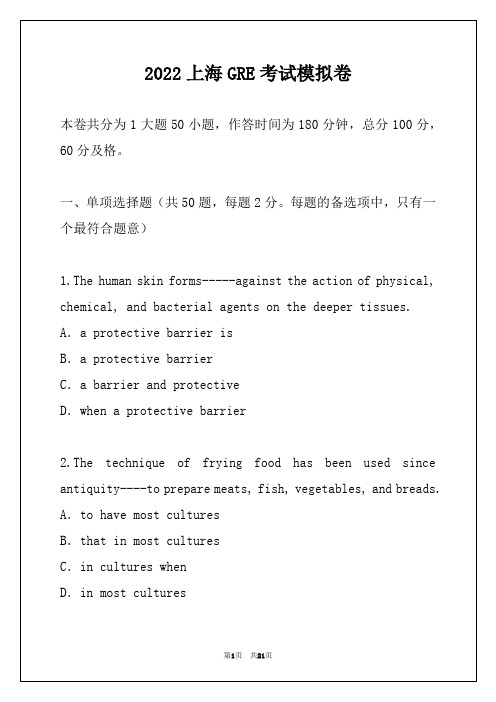
18.CONIFER: NEEDLE:: A.(A) potato: tuber B.(B) cactus: spine
23.Even though avant-garde attacks on the Victorian bourgeoisie were ------- in rhetoric, deficient in evidence, and malicious in intent, it does not follow that they had no ------- grounds. A.(A) infantile... cogent B.(B) florid... objective C.(C) steeped ... justificatory D.(D) spare ... intrinsic E.(E) judicious... realistic
第3页 共21页
B.are native of which C.which are native of D.of which are native
9.High-speed photography has made------certain aspects of motion never before seen, A.visible B.they are visible C.visibly D.it visible
5.United States income taxes are paid to the Internal Revenue Service, -----funds for use by the government. A.which distributes B.and distributes C.the distribution of D.so that the distribution of
gre模拟考试题及答案
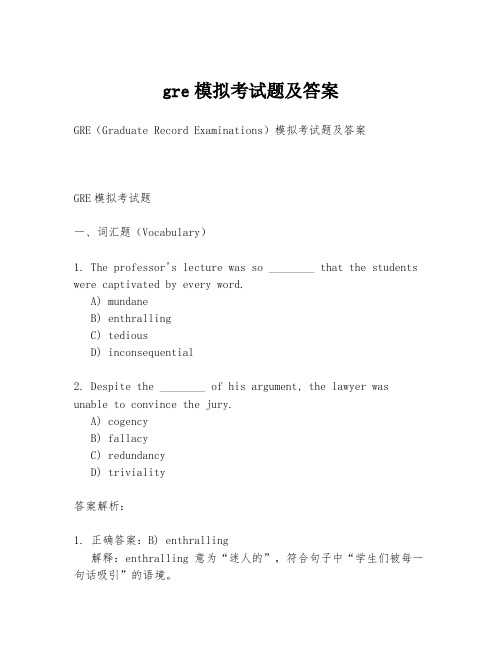
gre模拟考试题及答案GRE(Graduate Record Examinations)模拟考试题及答案GRE模拟考试题一、词汇题(Vocabulary)1. The professor's lecture was so ________ that the students were captivated by every word.A) mundaneB) enthrallingC) tediousD) inconsequential2. Despite the ________ of his argument, the lawyer was unable to convince the jury.A) cogencyB) fallacyC) redundancyD) triviality答案解析:1. 正确答案:B) enthralling解释:enthralling 意为“迷人的”,符合句子中“学生们被每一句话吸引”的语境。
2. 正确答案:A) cogency解释:cogency 意为“说服力”,尽管律师的论点很有说服力,但未能说服陪审团。
二、阅读理解题(Reading Comprehension)Passage:The Renaissance was a period of great cultural change and achievement in Europe that spanned the period roughly from the 14th to the 17th century. It marked the transition from the Middle Ages to Modernity, and during this time, there was a renewed interest in science, art, and literature.Question:What was the Renaissance known for?A) The decline of cultural achievementsB) The transition from the Middle Ages to ModernityC) The focus on religious themes in artD) The lack of interest in science and literature答案解析:正确答案:B) The transition from the Middle Ages to Modernity 解释:文章明确指出文艺复兴是从中世纪到现代性的过渡时期,标志着文化的巨大变化和成就。
考研英语模拟试卷22(题后含答案及解析)
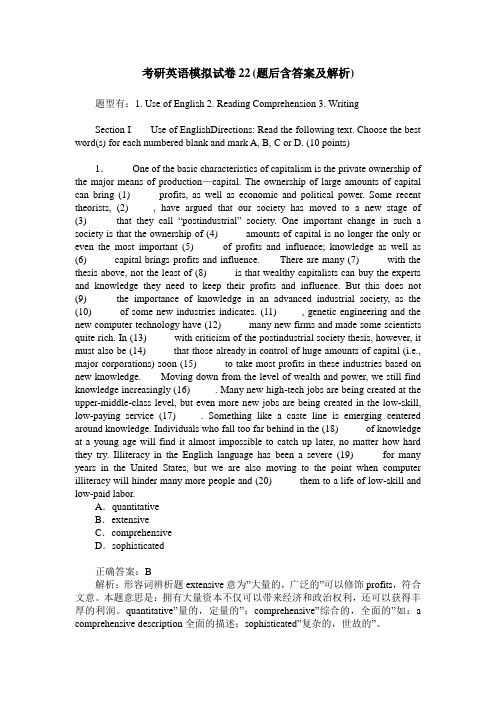
考研英语模拟试卷22(题后含答案及解析) 题型有:1. Use of English 2. Reading Comprehension 3. WritingSection I Use of EnglishDirections: Read the following text. Choose the best word(s) for each numbered blank and mark A, B, C or D. (10 points)1.One of the basic characteristics of capitalism is the private ownership of the major means of production—capital. The ownership of large amounts of capital can bring (1)_____ profits, as well as economic and political power. Some recent theorists, (2)_____, have argued that our society has moved to a new stage of (3)_____ that they call “postindustrial”society. One important change in such a society is that the ownership of (4)_____ amounts of capital is no longer the only or even the most important (5)_____ of profits and influence; knowledge as well as (6)_____ capital brings profits and influence. There are many (7)_____ with the thesis above, not the least of (8)_____ is that wealthy capitalists can buy the experts and knowledge they need to keep their profits and influence. But this does not(9)_____ the importance of knowledge in an advanced industrial society, as the(10)_____ of some new industries indicates. (11)_____, genetic engineering and the new computer technology have (12)_____ many new firms and made some scientists quite rich. In (13)_____ with criticism of the postindustrial society thesis, however, it must also be (14)_____ that those already in control of huge amounts of capital (i.e., major corporations) soon (15)_____ to take most profits in these industries based on new knowledge. Moving down from the level of wealth and power, we still find knowledge increasingly (16)_____. Many new high-tech jobs are being created at the upper-middle-class level, but even more new jobs are being created in the low-skill, low-paying service (17)_____. Something like a caste line is emerging centered around knowledge. Individuals who fall too far behind in the (18)_____ of knowledge at a young age will find it almost impossible to catch up later, no matter how hard they try. Illiteracy in the English language has been a severe (19)_____ for many years in the United States, but we are also moving to the point when computer illiteracy will hinder many more people and (20)_____ them to a life of low-skill and low-paid labor.A.quantitativeB.extensiveC.comprehensiveD.sophisticated正确答案:B解析:形容词辨析题extensive意为”大量的,广泛的”可以修饰profits,符合文意。
GRE(VERBAL)基础填空模拟试卷22(题后含答案及解析)
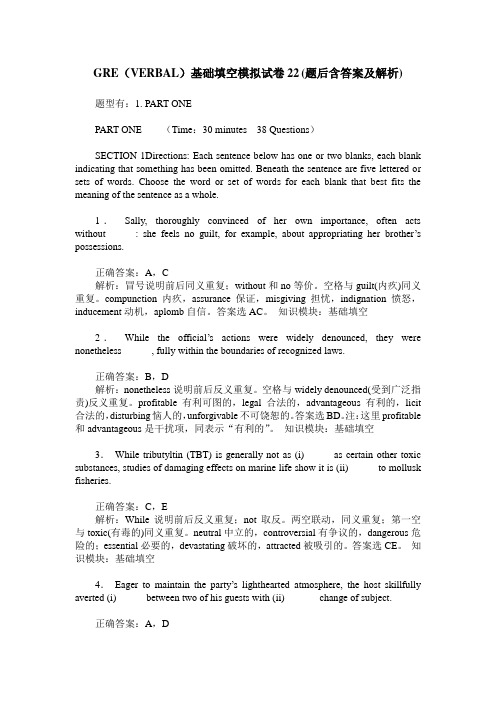
GRE(VERBAL)基础填空模拟试卷22(题后含答案及解析)题型有:1. PART ONEPART ONE (Time:30 minutes 38 Questions)SECTION 1Directions: Each sentence below has one or two blanks, each blank indicating that something has been omitted. Beneath the sentence are five lettered or sets of words. Choose the word or set of words for each blank that best fits the meaning of the sentence as a whole.1.Sally, thoroughly convinced of her own importance, often acts without______: she feels no guilt, for example, about appropriating her brother’s possessions.正确答案:A,C解析:冒号说明前后同义重复;without和no等价。
空格与guilt(内疚)同义重复。
compunction内疚,assurance保证,misgiving担忧,indignation愤怒,inducement动机,aplomb自信。
答案选AC。
知识模块:基础填空2.While the official’s actions were widely denounced, they were nonetheless______, fully within the boundaries of recognized laws.正确答案:B,D解析:nonetheless说明前后反义重复。
- 1、下载文档前请自行甄别文档内容的完整性,平台不提供额外的编辑、内容补充、找答案等附加服务。
- 2、"仅部分预览"的文档,不可在线预览部分如存在完整性等问题,可反馈申请退款(可完整预览的文档不适用该条件!)。
- 3、如文档侵犯您的权益,请联系客服反馈,我们会尽快为您处理(人工客服工作时间:9:00-18:30)。
GRE英语考试模拟试卷22试卷[模拟] 120选择第1题:A serious critic faces a dilemma: he must recognize the artistic element of uniquenessthat________subjective reaction; yet he must not be unduly________by such a reaction.A.requires ... prejudicedB.denies ... limitedC.warrants ... repelledD.invalidates ... attractedE.repudiates ... approbated第2题:Childhood memoirs often gain their poignancy through a sense of displacement: each lesson inexperience is accompanied by a loss of________.A.perspectiveB.innocenceC.veracityD.pessimismE.probity第3题:Although scientists have long________the human appendix as________organ, there is a growingbody of evidence indicating that the appendix does in fact have a significant function as a part of the body''s immune system.A.overestimated ... a minorB.discounted ... a vestigialC.valued ... a majorD.ignored ... a pivotalE.studied ... an inaccessible第4题:Data from inter-species genomic sequence comparisons and genome-wide expression profiling, integrated with various computational tools, are________to contribute to the decoding of genomic sequence andto________those sequences that orchestrate gene regulation.A.utilized ... locateB.unlikely ... detectC.prone ... decipherD.collected ... administerE.poised ... identify第5题:On the face of it, the plan under consideration is________. and indeed, has already sparkedprotests from several prominent politicians, who argue that "hasty implementation" could________the economy.A.hopeless … boostB.appealing … undermineC.contentious … inflameD.draconian … damageE.suspect … radicalize第6题:Regardless of what might be said about the vehement diatribes of the Minnesota senator, onecan''t argue that he was any less than utterly________his beliefs and his tituents, for invariably, he voted his________.A.opposed to ... politicsmitted to whimsC.conflicted in ... inclinationsD.considerate in ... platformE.dedicated to ... conscience第7题:Adams was so________that his friends did not bother to________him,because they presupposedthat he would pay scant attention.A.obstinate … infuriateB.obedient … refuteC.refractory … provokeD.intractable … remonstratearre … palliatePassage AThough agreeing with Descartes that consciousness and extension are qualitatively distinct, Spinoza's dual-aspect theory denied that consciousness and extension are inherent characteristics of two finite substances, treating them instead as attributes of the infinite substance of a transcendent intelligence. While mental occurrences can dictate only other mental occurrences and physical motions can determine only other physical motions, mind and body exist in pre-established coordination, since the same self-consistent intelligence establishes affinities and connections within both classes. Another alternative, psychophysical parallelism, retains both the dualism of mind and body and the notion of a regular correlation between mental and physical events, but avoids any assumption of causal mind-body connection, direct or indirect. Psychophysical parallelism eschews interactionism, stating that mental and physical could not possibly affect one another, and also rejects occasionalism and dual-aspect theory on the grounds that no third entity, including a transcendent intelligence, could be responsible for such vastly different effects. Parallelists accept only pure correlations, not causation, between mental and physical events.第8题:According to the passage, psychophysical parallelists would be LEAST likely to agree with which of the following views attributed to Spinoza?A.Through a relationship of correlation, mental occurrences can only determine other mental occurrences.B.Through a relationship of causation, physical occurrences can only determine other physical occurrences.C.Mind and body exist in pre-established coordination provided by a third entity, transcendent intelligence.D.Consciousness and extension, as separate finite qualities, may be described as distinct.E.One of the necessary attributes of any divine essence is its infinitude.第9题:According to the passage, which of the following events is most analogousto the relationship between thought and event articulated by psychophysical parallelism?A.A man looks in a mirror and, as a result, of the effect of cognition, sees his ownreflections.B.One thought in a sentient entity leads, by virtue of the stream of consciousness, to another thought.C.A match is struck, and through the effects of a physical law, it ignites into flame.D.Every time a pingpong ball is bounced, a tree falls, but through no causal relationship.E.A human being makes a mental judgment based on physical phenomena he has observed.第10题:The author cites Spinoza''s belief that "mind and body exist inpre-established coordination" most likely in order to________.A.prove that Descartes confused the true distinction between consciousness and extensionB.suggest the logical assumption behind Spinoza''s embrace of dualismy the groundwork for psychophysical parallelism'' s rejection of occasionalismD.deny that any outside entity could be responsible for both mental and physical eventsE.establish why he believed mental events could not determine physical motions第11题:It can be inferred from the passage that dual-aspect theory relies on what key assumption concerning the "transcendent intelligence" to establish the connection between mental and physical occurrences?A.The intelligence is omniscient with regard to mental and physical occurrences, envisioning all acts of causation in advance.B.The intelligence transcends consciousness and extension, but not other categories of substance.C.Only infinite substances can establish a unity of finite substances, whether that of a mental or physical nature.D.The intelligence exists in a state of invariable consistency, allowing the synthesis of different metaphysical categories.E.The intelligence is the only means of establishing a common category between distinct consciousnesses.第12题:ASTRONOMER: TELESCOPE:A.astrologer: constellationB.surgeon: pipetteC.conductor: batonD.carpenter: trowelE.cartographer: foolscap第13题:PERFECT: STIGMA : :A.misleading: deceptionB.paradigmatic: deviationC.solvent: contaminationD.impervious: immunityE.endurable: delicacy第14题:BRISTLE: ANGER : :A.blush: ridiculeB.cackle: appreciationC.vacillate: irresolutionD.blench: raptureE.flummox: engagement第15题:TENDER: ACCEPTANCE : :A.examine: solicitudeB.legalize: disapprobationC.submit: approvalD.announce: scrutinyE.perish: idea第16题:RATIOCINATION: LOGIC : :prehension: pedagogyB.interpretation: languageC.orthography : philatelyD.badminton: athleticsE.oration: elocution第17题:GAFFE: DECORUM: :A.feint: combatB.trick: perceptionC.dogma: dissentD.gaucherie: urbanityE.hyperbole: presentation第18题:RUBBER: TIRE : :A.skin: hairB.silver: cutleryC.window: paneD.erosion: ironE.piece: paper第19题:COLLUSION: CONSPIRATORS:A.edition: journalistsB.collaboration: partnersC.sportsmanship: umpiresD.ascription: translatorsE.summarization: critics第20题:APOSTATE: FAITH: :A.liar: honestyB.coward: cravennessC.convert: metamorphosisD.associate: statusE.wanderlust: virtue第21题:UNEARTH:A.mergeB.planC.admireplyE.conceal第22题:OBDURATE:A.estrangedB.nostalgicC.hesitantD.adaptableE.fanciful第23题:BAROQUE:A.refinedB.volatileC.simpleD.ornateE.brilliant第24题:EXTEMPORANEOUS:A.limitedB.peacefulC.premeditatedD.adeptE.supplementary第25题:LIBERTINE:A.convictB.dictatorC.asceticD.accumulatorE.slave第26题:SHUN:prehend innatelyB.affect simplyC.explore proactivelyD.respond accuratelyE.act intermittently第27题:IMMEDIATE:A.exhaustingB.manifoldC.prospectiveplicatedE.inadequate第28题:CAPRICIOUS:A.profoundB.directC.faithfulD.logicalE.deficient第29题:FULMINATION:A.approvalB.admirationC.recurrenceD.accumulationE.fleeing第30题:VERDANT:A.intelligibleB.sereC.sereneD.frostboundE.portentous第31题:EXECRABLE:A.incorrigibleudableC.naiveD.abundantE.sagacious。
